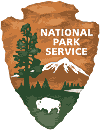Earth Science Week Classroom Activities
Ring of Fire

Activity Source:
National Park Service. Adapted with permission.
A plate boundary is a line on a map that defines the edge of a tectonic plate, usually indicating where one plate meets another. Plate boundaries are further divided by the direction that they are moving relative to one another.
When plates are moving towards one another, the point of contact is called a convergent plate boundary. When plates are moving away from each other, it is called a divergent plate boundary. Plates sliding past each other horizontally do so at a transform plate boundary.
In this activity, you’ll identify plate boundaries as well as continents, countries, and bodies of water to become familiar with an area known as the “Ring of Fire.” Download a detailed version of this activity (including instructions for teachers).
Materials
- Computer with Internet access
- Paper
- Colored pencils
Procedure
- Discuss: The Pacific Rim is a conglomeration of Pacific Ocean border countries including Australia, Peru, Argentina, China, Russia, Japan, Canada, and the United States each with its own economic, geographic, political, environmental and cultural backgrounds. The countries of the Pacific Rim have a rich history of interconnected trade, travel and geologic processes known as the Ring of Fire. How are the people living in the Pacific Rim interconnected and similar?
- Print up and study your own map of the Pacific Rim (http://geoalliance.asu.edu/sites/default/files/maps/pacificrim.pdf). Practice your skills at reading a map and using latitude and longitude to identify locations.
- Print up the “Mapping the Ring of Fire” handout and review instructions.
- Use various resources such as atlases, encyclopedia, plate tectonic maps, and the Internet to locate and label each item on the list with colored pencils.
- Go online to the “Mapping the Ring of Fire” main page (www.nps.gov/mora/forteachers/ring-of-fire.htm) and click on “Mapping the Ring of Fire PowerPoint” to view a slideshow with seismic maps of the Pacific Rim. During the slideshow, pause to sketch notes on your map when viewing the maps of seismic data of the Pacific Northwest, Southeast Asia, and the Pacific Rim.
- Also during the slideshow, pause and complete questions from the slideshow on a separate piece of paper.
- Draw in the plate boundaries of the plates located beneath the Pacific Ocean.
For additional maps of U.S. national parks, including those near you, go online to www.nps.gov/hfc/cfm/carto.cfm.
